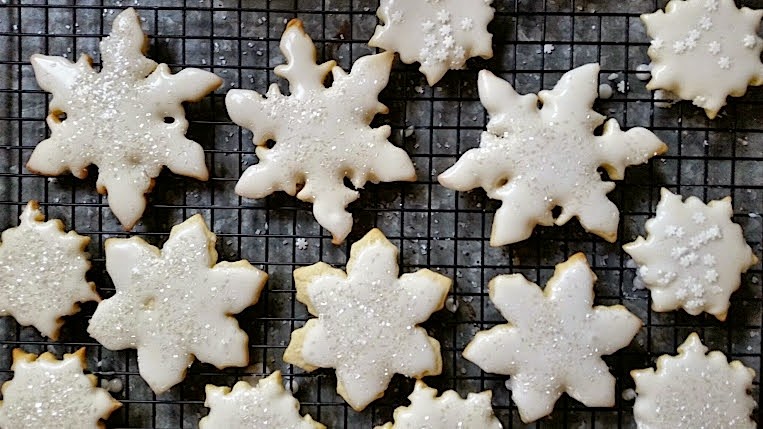The last few days have been a whirlwind of traveling with barely any time to sit, relax and catch my breath. As much as I would like a short reprieve from what seems like a constant state of motion, the rather loud voice in my head 'you need to get moving on the 'absolutely have to get done over the course of next few weeks' long list of things' won't allow it. And whether or not it's just me, there is something a little anti-climatic about receiving a box of homemade Christmas cookies and confections after the holidays. In spite of knowing everything will all get done (it always does) I still can't help but feel a little stressed out as there seems to be more things on the 'to do' list than there are hours in the day to get them done. Overextending myself is a way of life.
In addition to being incredibly delicious, sweet potatoes are one of those vegetables having multiple health benefits. Isn't it good to know that a casserole topped with mini-marshmallows might actually be better for you than you think? And what makes this casserole more flavorful and even more beautiful is the use of sweet potatoes having a deep orange or red color. Red Garnet or Hernandez varieties are usually available at most grocery stores or markets. But if you cannot find them, any sweet potato will work in this recipe.
Four pounds of sweet potatoes are baked in a preheated 400 degree oven for 75-90 minutes or until soft. Once cooled enough to handle, the sweet potato flesh is scooped out into a medium sized bowl.
You can use a food mill to puree the sweet potatoes, however, I have found mashing them with a fork works well. Personally I like this casserole to have a little texture to it. Once you have mashed the sweet potatoes to a relatively smooth consistency, the evaporated milk, granulated sugar, brown sugar, allspice, cinnamon, eggs, vanilla and melted butter are mixed in until fully incorporated.
The mixture is then poured into either a buttered oval casserole dish or 9"x12" baking dish.
Most sweet potato casseroles have a topping made of pecans, however, this one is topped with chopped roasted salted cashews transforming the humble root vegetable into something slightly more decadent. You could double the cashew topping and omit the mini-marshmallows if you are not a big fan of those white pillowy bites of goodness.
The entire casserole can be assembled a day ahead, covered, and refrigerated. I generally take the pre-asssembled, chilled casserole out of the refrigerator about an hour before baking and increase the baking time by approximately 15-20 minutes.
Because it was rather hectic here on Thanksgiving Day I wasn't able to capture a photo of what the Sweet Potato Casserole looked like when it finished baking. Just let me say that the browned mini-marshmallows and cashew topping make this a visually hard to resist dish.
Recipe
Sweet Potato Casserole (inspired by the Sweet Potato Casserole recipe shared in Saveur)
Updated November 25, 2020
Ingredients
4 pounds sweet potatoes, about 8-9 (recommend using Red Garnet or Hernandez sweet potatoes)
1/2 cup evaporated milk
1/4 cup granulated sugar
1/4 cup light brown sugar
6 Tablespoons unsalted butter, melted
2 teaspoons vanilla
1/2 teaspoon ground allspice or nutmeg
1/2 teaspoon cinnamon
1 teaspoon Kosher salt
2 Tablespoons honey
2 large eggs, lightly beaten
3/4 cup roasted salted cashews
1/2 cup light brown sugar
3 Tablespoons all-purpose flour
2 cups mini-marshmallows
Directions
1. Preheat oven to 400 degrees. Line a baking sheet with parchment paper.
2. Place sweet potatoes on baking sheet, bake until soft (approximately 75 to 90 minutes). Remove from oven and cool for approximately 30 minutes.
3. Reduce oven to 350 degrees.
4. Scoop sweet potato flesh into a medium sized bowl. Mash with a fork to a smooth consistency.
5. Whisk in evaporated milk, granulated sugar, brown sugar, melted butter, vanilla, allspice, cinnamon, salt, honey, and eggs.
6. Transfer mixture to lightly buttered oval baking casserole.
7. In a food processor, pulse together the cashews, brown sugar and flour until coarsely ground.
8. Sprinkle cashew mixture over the center of the casserole.
9. Sprinkle mini-marshmallows around perimeter of casserole.
10. Bake until marshmallows are golden brown and casserole is heated through, approximately 30 to 35 minutes.
2 large eggs, lightly beaten
3/4 cup roasted salted cashews
1/2 cup light brown sugar
3 Tablespoons all-purpose flour
2 cups mini-marshmallows
Directions
1. Preheat oven to 400 degrees. Line a baking sheet with parchment paper.
2. Place sweet potatoes on baking sheet, bake until soft (approximately 75 to 90 minutes). Remove from oven and cool for approximately 30 minutes.
3. Reduce oven to 350 degrees.
4. Scoop sweet potato flesh into a medium sized bowl. Mash with a fork to a smooth consistency.
5. Whisk in evaporated milk, granulated sugar, brown sugar, melted butter, vanilla, allspice, cinnamon, salt, honey, and eggs.
6. Transfer mixture to lightly buttered oval baking casserole.
7. In a food processor, pulse together the cashews, brown sugar and flour until coarsely ground.
8. Sprinkle cashew mixture over the center of the casserole.
9. Sprinkle mini-marshmallows around perimeter of casserole.
10. Bake until marshmallows are golden brown and casserole is heated through, approximately 30 to 35 minutes.
Note: (1) Kosher salt and honey were the ingredients added to the sweet potato. (2) Casserole can be prepared a day ahead. Remove from the refrigerator at least an hour before baking. Baking time might need to increase to 40-45 minutes.
Luculles, the most beautiful culinary antique store in the French Quarter (New Orleans).























































